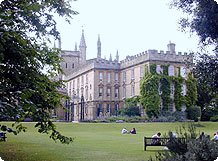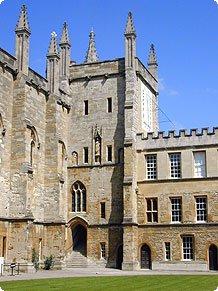


HOME
ARCHIVE
BOOKS
ABOUT
CONTACT
Rachel McCrindle
University of Reading
 |
 |
Welcome to Oxford, the city of dreaming spires, its skyline shaped by the golden stone buildings of the University with their spires, towers and domes. For over 900 years, Oxford has been a home to royalty and scholars, and since the 9th century an established town.
Although there is limited evidence of early Roman occupation around the city, it was really the Saxon Princess, St Frideswide, who around 727 AD founded a religious abbey on the site of Oxford's cathedral where Christ Church stands today. St Fideswide is often thought of as the 'founder' of the city, and it was the Oxenford, the original Saxon crossing point, that gave the city its name.
By the tenth century Oxford had become of strategic importance. Alfred the Great developed and fortified the city against the invading Danes and the city began to develop around the crossroads (Carfax) which is still the heart of the present city. After the Norman Conquest of 1066, King William gave Oxford to Robert D'Oilly who built Oxford's castle in 1072 and strengthened the city's ramparts. Richard the Lion heart was born at Beaumont Palace in 1157, and Charles 1 held parliament in the Convocation Hall during the Civil War.
Oxford University dates back to the 12th century and is the oldest English-speaking University in the world. Today it is made up of 39 colleges, each with its own governing body. There is no clear date of foundation, but teaching existed at Oxford in some form in 1096 and developed rapidly from 1167, when Henry II banned English students from attending the University of Paris.
In 1188, the historian, Gerald of Wales, gave a public reading to the Oxford dons and in 1190 Emo of Friesland became the first known overseas student. By 1201, the University was headed by a magister scolarum Oxonie, on whom the title of Chancellor was conferred in 1214, and in 1231 the masters were recognized as a universitas or corporation. In the 13th century, rioting between the townspeople and the students resulted in the establishment of primitive halls of residence which were later succeeded by the Oxford's colleges with University, Balliol and Merton Colleges, established between 1249 and 1264, being the oldest.
Oxford was soon recognized as being an eminent seat of learning. In 1355, Edward III paid tribute to the University for its invaluable contribution to learning and to the services rendered to the state by distinguished Oxford graduates. From 1878, academic halls were established for women, who became members of the University in 1920. Since 1974, all but one of Oxford's 39 colleges have changed their statutes to admit both men and women. St Hilda's remains the only women's college.
Early on, Oxford became a centre for research and lively debate, often of controversial issues, and it has continued in this vein as an international focus for learning and a forum for intellectual debate.
New College, our venue for ICDVRAT 2004, was founded in 1379 by the Bishop of Winchester, William of Wykeham (ca 1320-1404), about 200 years after the University came into existence. It is one of the largest and best-known colleges, and undeniably one of the most beautiful. The origin of the name 'New' stems from the fact that the College's 'official' name the College of St Mary is the same as that of Oriel College. Hence 'the new college of St Mary'. When founded, the College was new in several other ways. It was the first college for undergraduates, the first in which the senior members of the college had tutorial responsibility for undergraduates, and the first to be designed around the familiar quadrangle plan. Today, there are about 400 undergraduate and nearly 200 graduate students at the College.
Many leading luminaries have connections with Oxford and its University. Among these are 4 kings, 46 Nobel prizewinners, 25 UK Prime Ministers, 3 saints, 86 Archbishops and 18 Cardinals as well as many politicians, scientists, writers, broadcasters, actors and athletes. Recently celebrated has been the 50th anniversary of the first sub 4 minute mile, achieved by Sir Roger Bannister on the Iffley Road running track on 6th May 1954.
Oxford appears frequently as a setting for TV dramas and films such as Inspector Morse, Iris, Shadowlands, The Saint, True Blue and Harry Potter. It also has a long and distinguished literary history with many writers having spent time in Oxford and been inspired by the city. Amongst these authors are Lewis Carroll, JRR Tolkein, Oscar Wilde and Evelyn Waugh who based his famous novel Brideshead Revisited on his time at Hertford College.
It was during his time teaching at Christ Church that Charles Dodgson, a shy mathematics don, wrote the Alice in Wonderland stories under the pen name of Lewis Carroll. Alice was the daughter of Dean Liddell and the stories began one summer afternoon when Dodgson took Alice and her sisters out on the river. Alice's Shop in Through the Looking Glass was based on the shop opposite Christ Church in St Aldate's where the real-life Alice Liddell used to buy her barley sugar sweets.
Other notable children's favourites include The Chronicles of Narnia by C S Lewis and The Hobbit and The Lord of the Rings by J R R Tolkien. Both Lewis and Tolkien were leading members of The Inklings, Oxford's most famous literary group, that met regularly at The Eagle and Child pub in St Giles during the 1930's and 40's, to read extracts of their books to each other.
The Oxford University Museum of Natural History, where the conference reception will be held, houses the University's scientific collections of zoological, entomological, geological, palaeontological and mineralogical specimens, accumulated in the course of the last three centuries. The exhibits occupy a large centre court with its elegant cast iron columns supporting the great glass roof, and surrounded on four sides by upper and lower galleries. The museum is particularly renowned for it permanent display of dinosaurs, the largest display outside London; its reconstructions of the dodo, inspiration for the dodo in Lewis Carroll's Alice in Wonderland; and its live broadcasts to visitors of the museum of the swifts nesting in its tower. This study began in 1947 and is one of the longest running studies of any species of birds.
There are many other places of historical interest. These include Oxford's oldest building, the Saxon tower of St Michael at the Northgate, Cornmarket; the Bodleian library established over 400 years ago by Sir Thomas Bodley to house his collection of books; Sir Christopher Wren's Sheldonian Theatre built in 1664; the Ashmolean Museum, Britain's oldest museum and housing the university's world famous collections of art and archaeology; Christ Church whose college chapel is Oxford's cathedral, the smallest cathedral in England; the riverside botanic gardens opposite Magdalene College, and the garage in Longwall Street where in 1913 William Morris produced the first 'Bullnose' Morris Oxford thereby establishing Oxford as a leading centre of the motor industry.
Today, the city is a bustling town with a cosmopolitan range of restaurants and lively pubs, a wide variety of entertainment, excellent shopping and world-famous museums. Alongside the traditions of the University, Oxford is now also home to a growing hi-tech industry.
We hope that amidst the busy conference programme you will be able to find some time to explore all that Oxford has to offer. One good place to start might be the Oxford Story in Broad Street which, through a combination of films, interactive exhibits and a 25 minute indoor 'dark' ride, complete with the sounds and smells of the times, takes you through the University's 900 year history, allowing you to meet along the way, some of the writers, scientists and politicians whose careers began at Oxford.
| ICDVRAT Archive | Email | © 1996-2016 Copyright ICDVRAT |